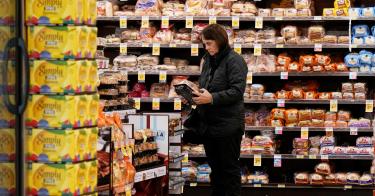If you’re struggling to pay for groceries, you’re not alone. Staples like bread, lunch meats, dairy products and eggs have seen price increases of 20% to 40% in the last three years. President Joe Biden is blaming grocery stores for “gouging” consumers, but there’s just one problem with that explanation: His administration’s own data disprove it.
According to the Bureau of Labor Statistics, prices paid by business and consumers alike have increased 18% on average since Biden took office. The higher prices that American families face today are simply the higher cost of doing business being passed along to the consumer.
Despite this fact, the White House has repeatedly called for grocery stores to lower prices—as if a business owner sets prices arbitrarily. In a recent commercial, Biden also highlighted the phenomenon of “shrinkflation,” where products get smaller, but the price remains the same. The president again called on companies to stop the practice, as if it could be done by executive fiat.
>>> Americans in Crosshairs of Cost-of-Living Crisis
Grocery stores cannot simply reduce the prices they charge while the prices they themselves pay continue to rise. If a dairy farmer charges a grocer 20% more for milk, then the grocer will also charge a family 20% more for milk. That’s not gouging anyone—it’s merely staying in business.
Over the last three years, firms have been slow to pass along the full freight of cost increases to consumers as those businesses sought to maintain market share. Only in the last couple of months has the increase in prices paid by consumers finally caught up to the higher prices paid by businesses.
That hasn’t stopped Biden from citing corporate profits, which are collectively at or near a nominal record high, as evidence of price gouging. However, he once again seems unaware of the data published by his own administration that directly contradict his talking points.
These record-high profits aren’t adjusted for inflation. That’s important since a business needs to use its earnings to buy new inventory, among other things. If the cost to replace inventory rises, then the money earned by the business doesn’t go as far as it used to. The same amount of money buys less.
Individuals are experiencing the same thing in their own finances. The average American worker is earning more per hour than ever before, but those earnings buy less than they did just three years ago. That’s because prices for the things the worker buys have risen much faster than his or her wages.
Adjusting for price increases reveals corporate profits have been falling lately, not rising, and record-setting numbers in business earnings are like the record wages earned by workers—both buy less.
Still, the fact that businesses are not to blame for high food prices is small consolation to American families who are having to pay not only a record high amount for food, but also a higher percentage of their income today than they did 30 years ago.
>>> Biden Blames Businesses for Inflation, but His Own Numbers Refute Him
And if greedy corporations gouging consumers aren’t the culprit, then what caused food prices to hit stratospheric levels so quickly? It was the unprecedented amount of government spending, borrowing and printing of money in the last few years.
By 2021, emergency COVID spending was going to sunset and federal government expenditures were set to plunge back to pre-pandemic levels. Instead, Biden advocated for replacing those trillions of dollars in one-time emergency spending with a plethora of left-wing boondoggles. Thus, multi-trillion-dollar deficits became institutionalized.
Growth in government spending today has so outstripped growth in the economy that the deficit is at levels never seen outside of a recession or emergencies—like a war or COVID. In collaboration with the big spenders in Congress, the Biden administration has added $6.7 trillion to the federal debt, and much of that borrowed money was financed by the Federal Reserve creating it out of thin air.
As the government spends, borrows and prints money, it devalues the currency, so your dollars don’t go as far as they used to. That’s something to remember next time you’re grocery shopping for your family and wondering why the prices are so high.
This piece originally appeared in MSN


